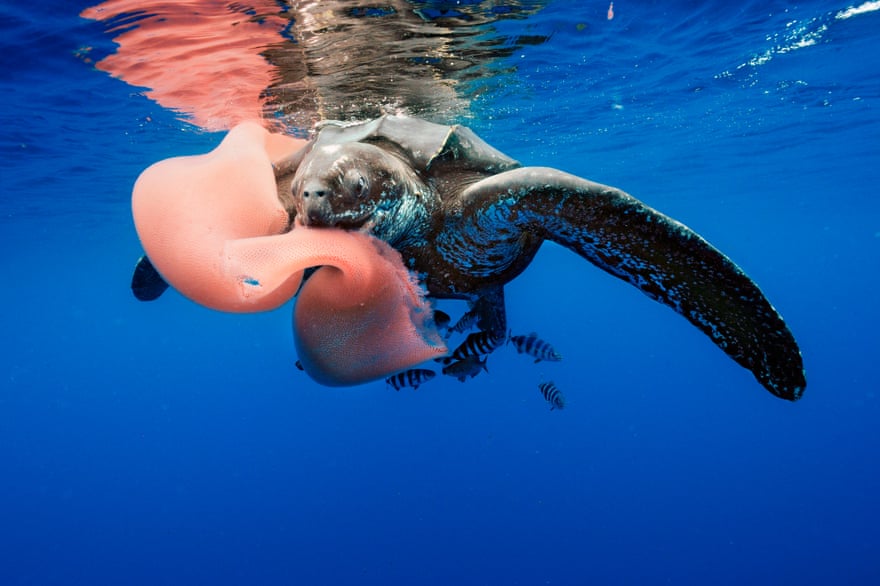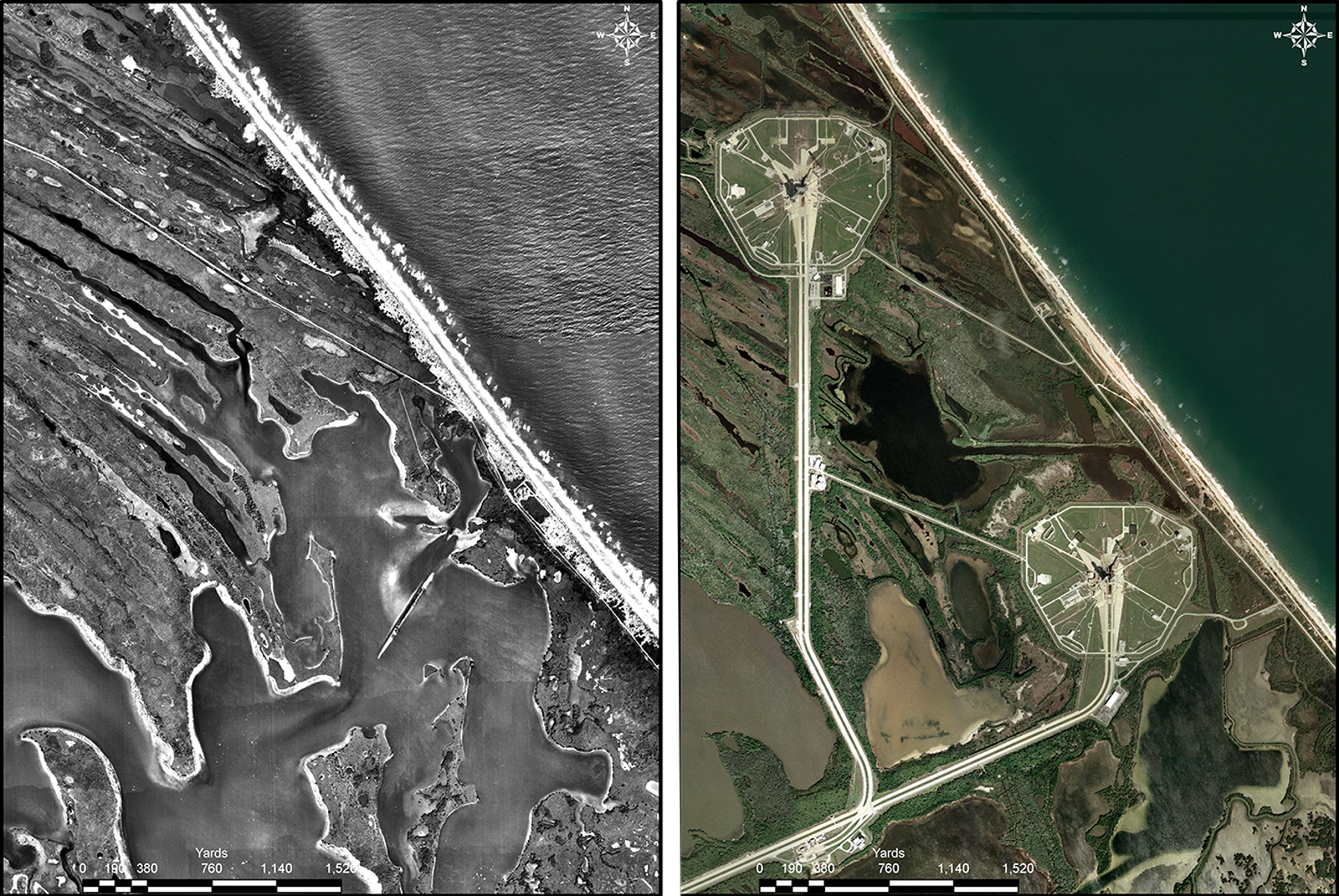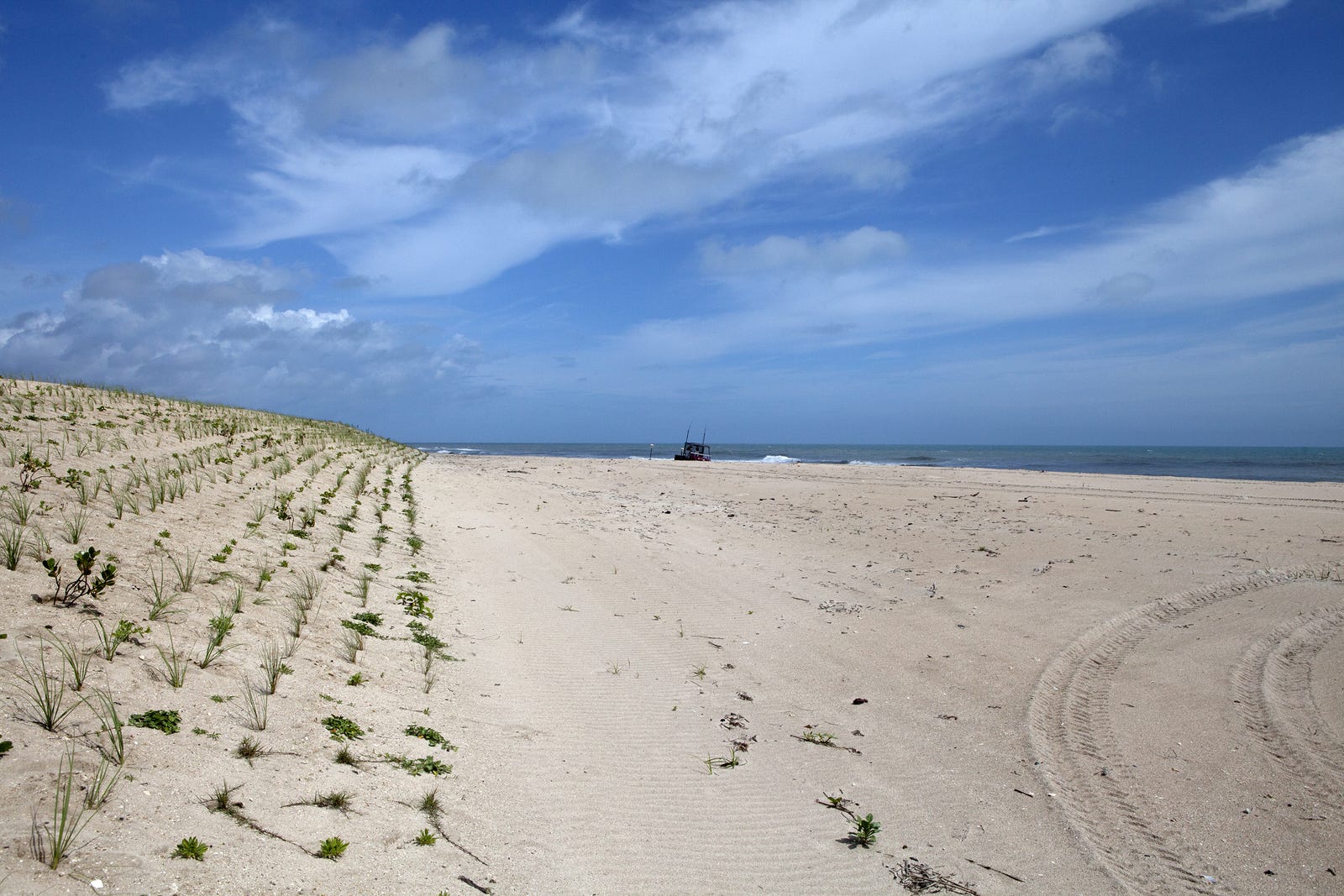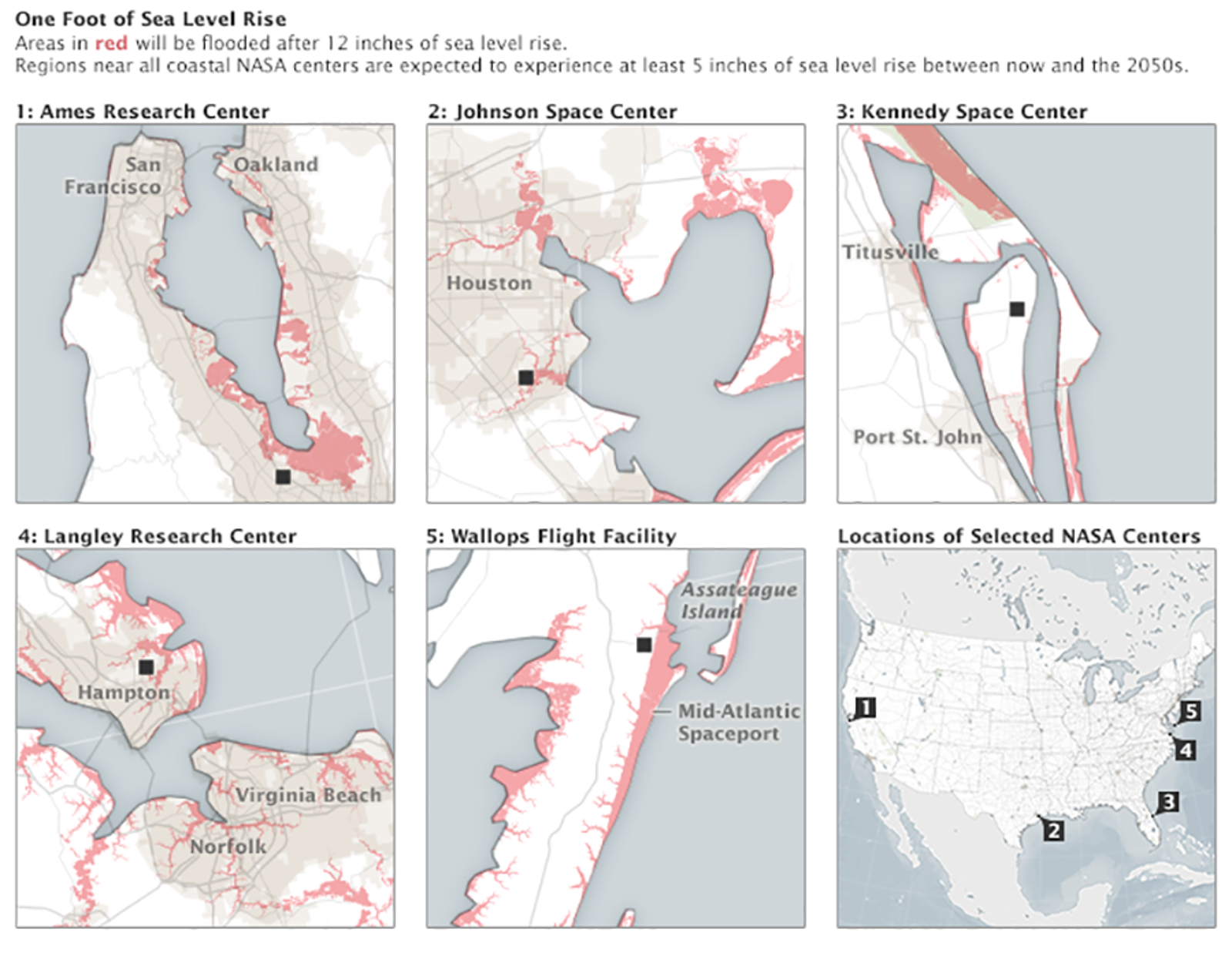From Gizmodo by Maddie Stone
In October 2012, just a few days before Hurricane Sandy slammed into
New Jersey, it was churning north past the narrow strip of white sand
beach separating NASA’s most celebrated spaceport from the sea.
For several days and nights, heavy storm surge pounded the shoreline,
flattening dunes and blowing sand right up to the launchpads.
A stone’s
throw away from the spot where a Saturn V rocket sent the first humans
to the Moon, the ocean took a 100-foot bite out of the beach.
“I
think the telling story is that the storm was almost 230 miles offshore,
and it still had an impact,” Don Dankert, an environmental scientist at
NASA, tells me as we stand with ecologist Carlton Hall atop a rickety
metal security tower overlooking Space Coast.
It is a hot, breathless
day, and the surf laps gently at the deserted shore.
“It makes you wonder what would happen if a storm like that came in much closer, or collided with the coast,” Dankert adds.
Space Coast with the GeoGarage platform (NOAA chart)
That’s a troubling question for NASA, an agency whose most valuable
piece
of real estate—the $10.9 billion sandbar called
Kennedy Space Center—is
also its most threatened.
The beating heart of American spaceflight
since the Apollo program, Kennedy was, and still is, the only place on
US soil where humans can launch into orbit.
Today, the center is
enjoying a revival, following a few dark years after the space shuttle
program was mothballed and crewed launches were outsourced to Russia.
The shuttle’s former digs, Launch Pad 39A, is being renovated by
commercial spaceflight company SpaceX for the Falcon Heavy, a beast of a
rocket designed to ferry astronauts into orbit and beyond.
A
few miles up the road, Launch Pad 39B is being modified for the SLS
rocket, which NASA hopes will send the first humans to Mars.
But a glorious future of
bigger
and badder rockets is by no means assured. In fact, that future is
gravely threatened, not by the budget cuts that NASA speaks
speaks often and candidly
about, but by climate change.
If humans keep putting carbon in the
atmosphere, eventually, Kennedy won’t be sending anybody into space.
It’ll be underwater.
Aerial view of Kennedy Space Center’s two Launch Pads, 39A and 39B,
along with the Launch Control Center, which includes the Vehicle
Assembly Building. Launch Pad 41b is located at Cape Canaveral Air Force
Station.
Image: Josh Stevens/NASA Earth Observatory/USGS
“We are acutely aware that, in the long-term sense, the viability of
our presence at
Space Coast is in question,” says Kim Toufectis, a
facilities planner in NASA’s Office of Strategic Infrastructure.
There’s a very good reason NASA built Kennedy Space Center, along
with four other launch and research facilities, on the edge of the sea.
If rockets are going to explode (and in 2016,
they still do),
we’d rather them explode over water than over people. “To launch to
space safely, you have to be at the coast,” says Caroline Massey,
assistant director for management operations at Wallops Flight Facility
in Virginia.
Kennedy’s location, at the southern end of the
Merritt Island wildlife refuge and just northwest of Cape Canaveral Air
Force Station, has a few other perks.
Launch pads and other resources
are shared with the Air Force, and weather conditions are good
year-round.
Being close to the equator allows rockets to snag a bigger
velocity boost from the rotation of the Earth.
And yet, even as architects were drawing up plans for Kennedy in the
early 1960s, NASA knew the spaceport’s exposure—to rising sea levels,
hurricanes, and the general wear and tear of the ocean—might one day
cause catastrophic damage.
“They were absolutely concerned about it,”
says
Roger Launius, associate director at the
Smithsonian National Air and Space Museum and former chief historian for
NASA.
“But they wanted to launch over water. You don’t want to drop
first stages over cities.”
Aerial view of Kennedy Space Center’s shoreline before any launchpads
were installed, left (1943) and in modern history (2007).
Photos
Courtesy John Jaeger.
Now, that water is rising.
Globally, sea levels have gone up about
eight inches since the early 1900s.
For the past two decades, the pace
of rise has been quickening, in step with
accelerated melting on the Greenland ice sheet.
At Kennedy, conservative climate models project 5 to 8 inches of sea
level rise by mid-century, and up to 15 inches by the 2080s.
Models that
take changing ice sheet dynamics into account predict as much as fifty
inches (4.2 feet) of rise by the 2080s.
In an even more dire scenario,
Space Coast sees over
six feet of rise by the end of the
century, causing many of the roads and launchpads, not to mention sewers
and buried electrical infrastructure, to become swamped.
“I hope we
don’t go there,” Hall said.
On top of rising seas, Kennedy
faces a stormier future—more extreme hurricanes in the summer and
nor’easters in the winter.
“We started to notice a real issue with
coastal erosion following the 2004 hurricanes,” says John Jaeger, a
coastal geologist at the University of Florida.
Jaeger is part of a team of scientists who’ve been studying long-term
shoreline recession at Space Coast, which can be traced back to the
1940s through aerial photographs.
But while natural erosion has been
reshaping Kennedy’s sandy fringes for decades, a recent uptick in
powerful storms has Jaeger worried for the future.
“As geologists, we
know it’s these big events that do all the work,” he says.
NASA’s Climate Adaptation Sciences Investigators Workgroup (CASI) shares this concern.
In a
recent review
of the space agency’s climate vulnerability, this team of in-house
Earth scientists and facilities managers cited extreme weather and
flooding as major hazards to future operations at Kennedy.
Even under
modest sea level rise scenarios, ten-year flood events are expected to
occur two to three times as often by mid-century.
And the more the ocean
rises, the easier it’ll be for storms to cause flooding.
“I use the metaphor that a small change in the average can lead to a
big change in extremes,” says Ben Strauss, vice president for sea level
rise and climate impacts at
Climate Central.
“In basketball, it’s pretty hard to get a slam dunk, but if you raised the floor a foot, they would happen all the time.”
In other words, the
coastal damage caused by Sandy may be a small taste of what Kennedy Space Center is in for.
After soaking in the view for a few moments, Dankert, Hall and I
climb down from the watchtower and drive south to Kennedy’s dune
restoration site, which
was completed in 2014
with federal Hurricane Sandy relief funds.
Stretching a little over a
mile between Launch Complexes 39A and 39B, the dune’s grassy slopes rise
like lightly yeasted bread over the sprawling beach.
If you didn’t know
better, you might think the shoreline had looked this way for
centuries.
View along the beach of Kennedy Space Center’s dune restoration site in 2014.
Photo Courtesy Dan Casper/NASA.
“We’re drawing a line in the sand,” Dankert says.
“The dune not only
prevents storm surge from plowing inland, it’s a sand source that
replenishes the beach.”
It’s an astonishingly low-tech barrier when you consider the
artificial pumping systems installed at Miami Beach to keep the ocean at bay, or the
enormous seawalls some experts think we’ll need to save Manhattan.
But in protecting its shoreline, NASA is trying to be considerate of
all
of its residents.
In addition to rockets, Kennedy is home to a stunning
array of wildlife, from bobcats and coyotes to southeastern beach mice,
scrub jays, and gopher tortoises.
It’s a major nesting site for
protected leatherback, green, and loggerhead sea turtles, with thousands
of baby turtles born on this small stretch of beach each year.
“We are a wildlife refuge—that is a huge part of our program,”
Dankert says, adding that in addition to maintaining the shoreline,
Kennedy’s newly-restored dune blocks artificial light from the launch
pads, which can disorient female sea turtles as they’re coming ashore to
nest.
For the past few years, the dune has held strong,
preventing the ocean from spilling over onto the historic shuttle
railroad that traces along the coast.
Eventually, NASA would like to put
in another two miles of dune, fortifying the entire shoreline between
Launch Complexes 39A and 39B.
As with all government projects, the hang-up is funding.
The
post-Sandy dune reconstruction was completed for a cool $3 million,
using beach-quality sand trucked up from Cape Canaveral.
“We got really
lucky—that sand was a big cost-saver,” Hall says, noting that the bill
might have run in the tens of millions had NASA been forced to dredge
sand from offshore.
An Atlas V rocket lifts off from Cape Canaveral Air Force Station’s
Launch Complex 41, illumining nearby Kennedy Space Center’s dune
restoration site.
Photo Courtesy Tony Gray/NASA.
Still, ten, twenty, or even fifty million dollars pales in comparison
to the value of the launchpads that sit just a quarter mile inland.
“To
rebuild a pad is a few billion dollars,” Hall says.
“To spend a few
million every few years instead is a pretty good investment.”
Although Kennedy is NASA’s most threatened asset,
all of the space agency’s properties—some $32 billion worth of infrastructure
used
for scientific research, aeronautics testing, astronaut training, deep
space missions, and vehicle assembly—face challenges in a changing
climate.
Sea levels at the Johnson Research Center in Texas are rising
at a whopping 2.5 inches (6.4 centimeters) per decade, faster than any
other coastal center by a factor of two or three.
The Michoud Assembly
Facility in New Orleans sits below sea level, surrounded by 19 foot-high
levees, on rapidly-sinking ground. Inland facilities are bracing for
more excessively hot days, and the Ames Research Center in Silicon
Valley is preparing for a future of drought.
“This is a very
large concern for our agency as a whole,” Toufectis says.
And given our
growing need to go into space, not just for scientific research, but
to harness new resources,
colonize other worlds, and
monitor and study the one overburdened biosphere we’ve got, anything that threatens future operations and NASA threatens the entire nation.
At
Wallops Flight Facility on Virginia’s eastern shore, climate change
isn’t some existential problem for the future—it’s reality.
The center’s
sounding rocket launch pads, which have sent countless aircraft models
and science experiments into suborbital space, sit on a six square-mile
barrier island just a few hundred feet from the ocean, alongside two
Virginia-owned pads used for satellite launches and ISS resupply runs.
Sea levels are rising, storms are getting fiercer, and protective
beaches are eroding rapidly.
“We live with climate change every day,”
Massey says.
Areas around five coastal NASA centers that would be inundated by 12
inches (30 cm) of sea level rise (red).
Image: Josh Stevens/NASA Earth
Observatory
Wallops Island started hardening its defenses in earnest in the ‘90s,
when NASA erected a 3.5 mile stone seawall in front of the launch pads.
But while the wall initially helped to reduce storm damage, the beach
beyond it was soon worn to shreds.
By the mid 2000s, storm waves were
breaking directly against the wall, causing sections to crumble into the
sea.
And so, in the spring of 2012 and the summer of 2014, with a $54
million investment from Congress, NASA and the US Army Corps of
Engineers dredged almost 4 million cubic yards of sand from offshore,
and a new beach was built beyond the wall.
The impact was sudden and
dramatic.
“When Hurricane Irene hit in 2011, Wallops [Island] was
flooded, we had $3.8 million in storm damage, and we couldn’t work there
for a few weeks,” Massey says.
But when Sandy, virtually the same
strength as Irene, blew past Virginia’s coastline a year later?
“There
was no island flooding to speak of, and we could have kept the power on
the entire time,” Massey says.
“The only difference was our shoreline
protection program.”
At Wallops as at Kennedy, shoring up the shoreline every few years is
considered an economical way to manage the risk right now.
But looking
out toward the late 21st century and beyond, NASA may be forced to leave
some of these launchpads behind.
“In the long-term, I would be shocked
if we don’t see more than six feet of sea level rise,” Strauss says.
“That amount may simply be incompatible with a lot of NASA’s coastal
infrastructure.”
Picking up and moving inland, or “managed retreat” in the urban
planning parlance, is the last thing the space agency wants to do.
Ironically, it probably won’t be a major storm or flood that forces
NASA’s hand.
It’ll be its employees.
You can’t have rocket launches on
Space Coast if you can’t find engineers, mission directors and launch
personnel willing to run them—which is to say, people willing to live
and work in an increasingly hostile environment.
“The point at which we get serious about moving is the point at which the community is no longer viable,” Toufectis said.
Full-scale withdrawal at any of NASA’s centers is probably decades
away.
But at Wallops, the seeds of a managed retreat mentality are
already starting to sink in.
There’s now an intensive screening process
for what can be built on the island: “It has to be something we can only
do safely over water,” says Josh Bundick, program manager for
management operations at Wallops.
Newer buildings are placed on elevated pilings or raised floors, with
all critical electrical infrastructure installed above the flood line.
Island operations are run by a skeleton crew, while the vast majority of
Wallops employees work at the facility’s main base a few miles inland.
NASA hasn’t broken off its relationship with Wallops Island, but it is
creating distance.
As I head back to Kennedy’s visitor center, ogling the tremendous
Vehicle Assembly Building where the Saturn V rocket was put together, I
can’t help but feel a strange sense of cognitive dissonance.
Here I am,
at a place that radiates optimism, that flaunts the raw power of human
technology that was built to explore the infinite, only to learn of
man’s essential helplessness in the face of nature.
The sense of two
parallel realities grows stronger as I return to my hotel in Titusville,
where gaggles of tourists take selfies with replica astronaut suits and
locals share beers over the latest SpaceX gossip.
This isn’t a
community with any intention of going anywhere.
But no matter
what the future holds for Space Coast, one thing is clear: defending
this shoreline now isn’t a waste.
Places on the front lines of climate
change have lessons to teach us about standing one’s ground, and
deciding when the ground can no longer stand.
And those lessons may wind
up being more valuable than a hundred launchpads.
“Look, human beings are all mortals,” Strauss says.
“But that doesn’t
stop us from leading meaningful lives. I could tell you that the
barrier islands on the Atlantic coast may not survive this century and
almost certainly won’t survive the next, but that doesn’t mean we can’t
make good use of them now. We just have to keep our eyes open.”
Links :









